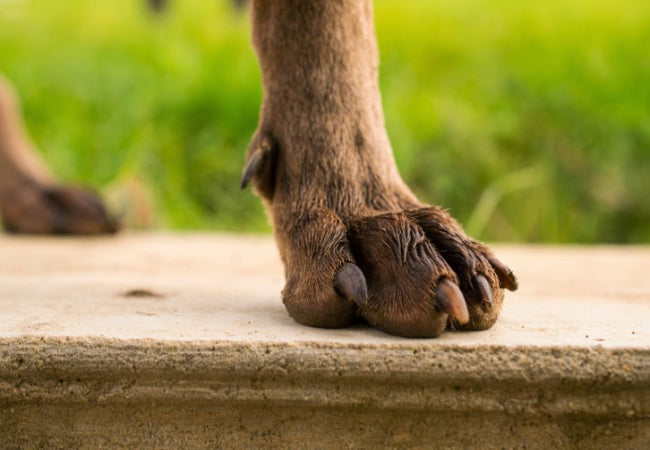Why Dogs Have Claws 2025: Vet-Approved Purpose & Care 🐾✨

In this article
Why Dogs Have Claws 2025: Vet-Approved Purpose & Care 🐾✨
By Dr. Duncan Houston BVSc
Dogs’ claws are small but powerful tools that play an important role in their daily lives. From helping them move efficiently to allowing natural behaviors like digging and play, understanding why dogs have claws and how to care for them is essential for every pet owner.
In this guide, we’ll cover:
-
The natural purposes of dog claws
-
Differences between dog claws and cat claws
-
Common problems caused by overgrown or damaged claws
-
Tips for maintaining healthy claws
1. Mobility and Traction 🏃♂️
Claws give dogs the traction they need to move confidently across different surfaces. Dogs rely on their claws to:
-
Run and sprint safely: Claws help prevent slipping when chasing toys, other dogs, or wildlife.
-
Turn sharply: Agile movements during play or in a hunt-like scenario are assisted by claws.
-
Climb and balance: Dogs climbing hills, rough terrain, or even furniture can rely on their claws for stability.
Without properly maintained claws, dogs may develop a wobbly gait, painful pressure points on their paws, or even injuries to joints due to improper footing.
2. Digging: A Natural Instinct ⛏️
Digging is one of the most instinctive behaviors in dogs. Their claws are perfectly designed to dig through dirt, sand, and even soft surfaces. Dogs dig to:
-
Find cooler spots to lie down.
-
Bury food, toys, or bones for later (a survival instinct).
-
Explore scents or small creatures underground.
Certain breeds, such as Terriers, Dachshunds, and Huskies, are natural diggers and may require designated areas or enrichment activities to channel this behavior safely.
3. Holding and Manipulating Objects 🧸
Although less obvious, claws help dogs manipulate objects and toys. Dogs may use their claws to:
-
Stabilize chew toys during play.
-
Move objects around their environment.
-
Assist in puzzle feeders or interactive games.
This ability is particularly useful for intelligent breeds like Border Collies, Australian Shepherds, and Labrador Retrievers, who thrive on mental stimulation.
4. Defense and Survival 🛡️
While dogs primarily defend themselves with their teeth, their claws can also serve as tools for protection. They provide:
-
Extra leverage when scratching or pawing at threats.
-
Stability when trying to escape a dangerous situation.
Though domestic dogs rarely use claws aggressively, wild ancestors relied on them for hunting and defense, and some of this instinct remains today.
🐶 Non-Retractable vs. Retractable Claws
Unlike cats, dog claws are non-retractable, meaning they are always exposed. This has several implications:
-
Natural wear occurs from walking and running, but indoor dogs may not wear down their nails enough.
-
Overgrown nails can cause pain, deformities, or joint stress.
-
Dogs with excessively long claws may change how they walk, which can affect posture and mobility.
✂️ Common Claw Problems
Even with natural wear, dogs can experience issues with their claws, including:
-
Overgrown nails – Can curl, dig into pads, or break.
-
Splits and cracks – Common in active dogs or those running on rough surfaces.
-
Infections or abscesses – Can occur from injuries or fungal infections.
-
Ingrown nails – Nails grow into the paw pad, causing pain and infection.
Early detection is key. Regular inspection during grooming can prevent serious problems.
✅ Maintaining Healthy Claws
Here’s how to keep your dog’s claws in top condition:
-
Regular trimming: Most dogs need a trim every 3–6 weeks, depending on activity level.
-
Check for injuries: Inspect paws after walks, especially on rough terrain.
-
Provide rough surfaces: Pavement or gravel helps wear down nails naturally.
-
Use proper tools: Use dog-specific clippers or grinders to avoid splintering.
-
Professional grooming: Some dogs are difficult to handle and benefit from a groomer’s help.
🐾 Fun Facts About Dog Claws
-
Dogs have dewclaws, an extra claw on the inside of the front legs. Some breeds also have rear dewclaws. These may need special care since they don’t touch the ground.
-
Nail health can reflect overall health. Brittle, discolored, or slow-growing nails may indicate nutritional deficiencies or illness.
-
Dogs’ claws grow continuously throughout their lives, similar to human nails.
🌟 Conclusion
Dog claws are multifunctional tools essential for mobility, play, digging, and natural behavior. Proper care, trimming, and observation are critical to maintaining healthy paws and preventing discomfort or injuries.



